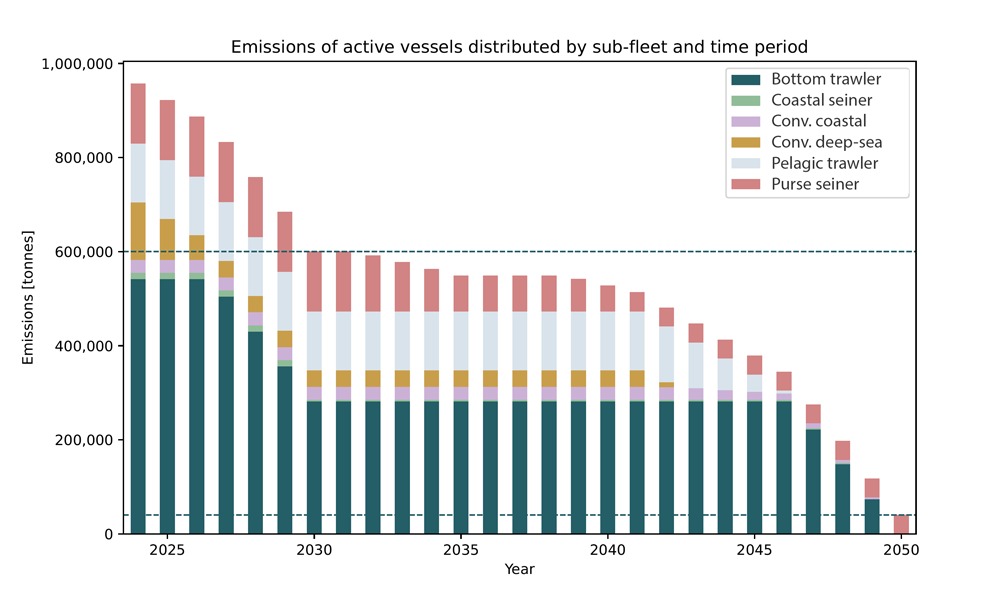
The Norwegian fishing fleet is now facing a significant environmental challenge. With over 5,000 fishing vessels, including around 1,850 highly active in generating catch income, the fleet releases around 1 million tonnes of CO2 each year, accounting for 2.7% of Norway’s total emissions. As climate change accelerates, reducing these emissions is more important than ever. Norway has ambitious climate goals, aiming to cut emissions by 55% by 2030 and achieve near-zero emissions by 2050. These targets can only be achieved by renewing the fishing fleet with zero-emission vessels and changing how the fleet operates.
The environmental challenge of Norway’s fishing fleet
Despite ongoing efforts to cut emissions, the Norwegian fishing fleet’s CO2 levels have stopped decreasing and are back to what they were in 2005. This is a major problem for reaching Norway’s climate targets. The fleet is diverse, with both small and large vessels involved in various fishing activities. Although the deep-sea vessels account for only about 15% of the fleet, they are responsible for over 75% of the emissions. Still, the smaller coastal vessels also play an important role in decarbonising the entire fleet.
Determining how to renew the fleet and introduce new, low- and zero-emission technologies is therefore an important step in the transition towards a zero-emission fishing fleet. However, this transition is not only a technical challenge but also an economic one as new systems and infrastructure are expensive.
Strategic fleet renewal: A path to zero-emission fishing
To examine how changes in external factors, such as carbon taxes and technological advancements, influence the best strategy for decarbonising the Norwegian fishing fleet – and to gain insights into key drivers for a smooth and rapid transition to zero emissions in the fisheries sector – we developed a mathematical optimisation model for the Fishing Fleet Renewal Problem with Emission Constraints (FFRPEC).
A mathematical optimisation model is a type of tool used to find the best way to achieve a goal, especially when there are multiple options or constraints. It works by setting up an equation or series of equations that represent a real-life problem – like reducing the emissions of the Norwegian fishing fleet. The model then calculates the most effective solution by trying out different combinations and adjusting the variables until it finds the best possible outcome within any given limits (like budget, time, or resources). In essence, it helps policymakers choose the best option in complex situations.
This model focuses on determining the timing and type of technology to use when renewing the existing vessels so that their CO2 emissions are reduced in line with the Norwegian climate targets. The model assumes that an existing vessel will always be replaced by an equivalent vessel with a low- or zero-emission propulsion system. It does not consider the impact of Norway’s fisheries management policies on these decisions. For a first analysis of possible transition pathways, the following propulsion systems were included:
- Diesel-Mechanic: Common but high in emissions.
- Diesel-Electric: Slightly lowers emissions through peak shaving.
- Electric-Mechanic Hybrid: Uses both electric and diesel power for better efficiency.
- Electric-Hydrogen Hybrid: Zero emissions using hydrogen fuel cells.
- Electric-Ammonia Hybrid: Promising zero-emission technology for the future.
Key insights from our model
The FFRPEC model was applied to Norway’s active fishing vessels with different scenarios, revealing different key insights:
- Emission targets drive fleet renewal: Decisions to renew the fleet are primarily driven by the need to meet emission targets rather than achieving cost savings.
- Deep-sea vessels as an immediate priority: Deep-sea vessels should be renewed first as they are responsible for about 95% of the fleet’s total emissions.
- Economic incentives are essential for adoption: Higher CO2 taxes and higher marine gas oil (MGO) costs are needed to accelerate the use of zero-emission technologies.

Leading the way to sustainable fisheries
Decarbonising the Norwegian fishing fleet is an important step towards reaching national and global climate goals. Norway can lead the way in sustainable fisheries by adopting advanced, zero-emission propulsion systems and implementing supportive policies. Still, policymakers must create economic and regulatory measures to support the transition. This includes designing an incentive scheme for the use for zero-emission technologies. Immediate action is needed to meet climate goals and ensure a greener future for the next generations.




